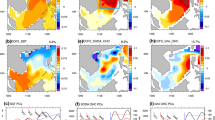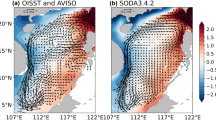Abstract
Spatial distribution of the South China Sea (SCS) surface temperature shows strong cold anomalies over the Sunda Shelf during the boreal winter season. The band of low sea surface temperature (SST) region located south/southeast of Vietnam is called as the winter cold tongue (CT) in the SCS. Using observational and re-analysis datasets a comprehensive investigation of the dynamical and thermodynamical processes associated with the evolution of SCS CT is performed in this study. The role and relative importance of wind-driven ocean transports, air–sea heat fluxes and oceanic processes are explored. The north-south Sverdrup transport demonstrates strong southward transport during the northeast monsoon period aiding the SST cooling by bringing relatively cold water from the north. The zonal and meridional Ekman transports exhibit relatively weak westward and northward transports to the CT region during this period. The study suggests that wind-driven ocean transports have a significant role in regulating the shape and spatial extent of the CT. The heat budget analysis revealed that net surface heat flux decrease during the northeast monsoon acts as the primary cooling mechanism responsible for the development of the SCS CT, while the horizontal advection of cold water by the western boundary current along the coast of Vietnam plays a secondary role. The wintertime SST anomalies over the CT region are significantly linked to the Nino3 index. Most of the warming/cooling events in the SST anomalies coincide with the El Nino/La Nina phenomena in the Pacific Ocean.













Similar content being viewed by others
References
Alexander MA, Scott JD (2008) The role of Ekman Ocean heat transport in the Northern Hemisphere response to ENSO. J Clim 21:5688–5707
Alexander MA, Bladé I, Newman M, Lanzante JR, Lau N-C, Scott JD (2002) The atmospheric bridge: the influence of ENSO teleconnections on air–sea interaction over the global oceans. J Clim 15:2205–2231
Berry DI, Kent EC (2009) A new air–sea interaction gridded dataset from ICOADS with uncertainty estimates. Bull Am Meteorol Soc 90:645–656
Berry DI, Kent EC (2011) Air–sea fluxes from ICOADS: the construction of a new gridded dataset with uncertainty estimates. Int J Clim 31:987–1001
Carton JA, Giese BS (2008) A reanalysis of ocean climate using Simple Ocean Data Assimilation (SODA). Mon Wea Rev 136:2999–3017
Chao CY, Shaw PT, Wu SY (1996) El Nino modulations of the South China Sea circulation. Prog Oceanogr 38:51–93
Chen J-M, Chang C-P, Li T (2003) Annual cycle of the South China Sea surface temperature using the NCEP/NCAR reanalysis. J Meteorol Soc Jpn 81:879–884
Chu PC, Lu S, Chen Y (1997) Temporal and spatial variabilities of the South China Sea surface temperature anomaly. J Geophys Res 102: 20, 937–20, 955
de Boyer MC, Vialard J, Shenoi SSC, Shankar D, Durand F, Ethé C, Madec G (2007) Simulated seasonal and interannual variability of mixed layer heat budget in the northern Indian Ocean. J Clim 20:3249–3268
Dee DP et al (2011) The ERA-Interim reanalysis: configuration and performance of the data assimilation system. Q J R Meteorol Soc 137:553–597
Fang G, Chen H, Wei Z, Wang Y, Wang X, Li C (2006) Trends and interannual variability of the South China Sea surface winds, surface height, and surface temperature in the recent decade. J Geophys Res 111:C11S16. doi:10.1029/2005JC003276
Huang E, Tian TJ, Steinke S (2011) Millennial-scale dynamics of the winter cold tongue in the southern South China Sea over the past 26 ka and the East Asian winter monsoon. Quat Res 75(1):196–204
Jerlov NG (1968) Optical oceanography. Elsevier, New York, p 194
Jhun J-G, Lee E-J (2004) A new East Asian winter monsoon index and associated characteristics of the winter monsoon. J Clim 17:711–726
Klein SA, Soden BJ, Lau N-C (1999) Remote sea surface variations during ENSO: evidence for a tropical atmospheric bridge. J Clim 12(4):917–932
Koseki S, Koh T-Y, Teo C-K (2013) Effects of the cold tongue in the South China Sea on the monsoon, diurnal cycle and rainfall in the Maritime Continent. Q J R Meteorol Soc 139:1566–1582
Levitus S (1987) Meridional Ekman heat fluxes for the world ocean and individual ocean basins. J Phys Oceanogr 17:1484–1492
Liu WT, Xie X (1999) Space based observations of the seasonal changes of the south Asian monsoon and oceanic responses. Geophys Res Lett 26:1473–1476
Liu Q, Jiang X, Xie S-P, Liu WT (2004) A gap in the Indo-Pacific warm pool over the South China Sea in boreal winter: seasonal development and interannual variability. J Geophys Res (Oceans) 109:C07012. doi:10.1029/2003JC002179
Liu Q, Jiang X, Xie S-P, Liu WT (2005) Sea surface wind and cold tongue over the winter South China Sea. IEEE Int 5:3294–3297
Liu Q-Y, Wang D, Wang X, Shu Y, Xie Q, Chen J (2014) Thermal variations in the South China Sea associated with the eastern and central Pacific El Niño events and their mechanisms. J Geophys Res (Oceans) 119:8955–8972
Madhusoodanan MS, Thompson B (2011) Decadal variability of the Arctic Ocean thermal structure. Ocean Dyn 61:873–880
Price JF, Weller RA, Schudlich RR (1987) Wind-driven ocean currents and Ekman transport. Science 238:1534–1538
Qu T (2001) Role of ocean dynamics in determining the mean seasonal cycle of the South China Sea surface temperature. J Geophys Res 106:6943–6955
Qu T, Du Y, Strachan J, Meyers G, Slingo J (2005) Sea surface temperature and its variability in the Indonesian region. Oceanography 18(4):50–61
Reynolds RW, Smith MTM, Liu C, Chelton DB, Casey KS, Schlax MG (2007) Daily high-resolution-blended analyses for sea surface temperature. J Clim 20:5473–5496
Shen S, Lau K-M (1995) Biennial oscillation associated with the East Asian summer monsoon and tropical sea surface temperature. J Meteorol Soc Jpn 73:105–124
Shenoi SSC, Shankar D, Shetye SR (2005) On the accuracy of the simple ocean data assimilation analysis for estimating heat budgets of the Near-Surface Arabian Sea and Bay of Bengal. J Phys Oceanogr 35:395–400
Stommel H (1965) The Gulf stream. University of Calif Press, Berkeley, p 248
Thompson B, Tkalich P (2014) Mixed layer thermodynamics of the Southern South China Sea. Clim Dyn 43:2061–2075
Tomita T, Yasunari T (1996) Role of the northeast winter monsoon on the biennial oscillation of the ENSO/monsoon system. J Meteorol Soc Jpn 74:399–413
Varikoden H, Samah AA, Babu CA (2010) The cold tongue in the South China Sea during boreal winter and its interaction with the atmosphere. Adv Atmos Sci 27(2):265–273
Vialard J, Delecluse P (1998) An OGCM study for the TOGA Decade. Part I: role of salinity in the physics of the Western Pacific Fresh Pool. J Phys Oceanogr 28:1071–1088
Wang C, Wang W, Wang D, Wang Q (2006) Interannual variability of the South China Sea associated with El Niño. J Geophys Res 111:C03023. doi:10.1029/2005JC003333
Wyrtki K (1961) Physical oceanography of Southeast Asian waters: scientific results of marine investigations of the South China Sea and Gulf of Thailand. Scripps Institution of Oceanography, NAGA Rep 2, La Jolla, p 195
Acknowledgments
This research was supported by the National Research Foundation Singapore through the Singapore MIT Alliance for Research and Technology’s Centre for Environmental Sensing and Modeling interdisciplinary research program. The authors thank the reviewers and the editor for their constructive comments to improve the manuscript. We acknowledge NCDC-NOAA, ECMWF, UMD, NOC and Aviso for the AVHRR OISSTv2, ERA-interim, SODA, NOC flux and Ssalto/Ducas geostrophic current field data sets respectively.
Author information
Authors and Affiliations
Corresponding author
Rights and permissions
About this article
Cite this article
Thompson, B., Tkalich, P., Malanotte-Rizzoli, P. et al. Dynamical and thermodynamical analysis of the South China Sea winter cold tongue. Clim Dyn 47, 1629–1646 (2016). https://doi.org/10.1007/s00382-015-2924-3
Received:
Accepted:
Published:
Issue Date:
DOI: https://doi.org/10.1007/s00382-015-2924-3




